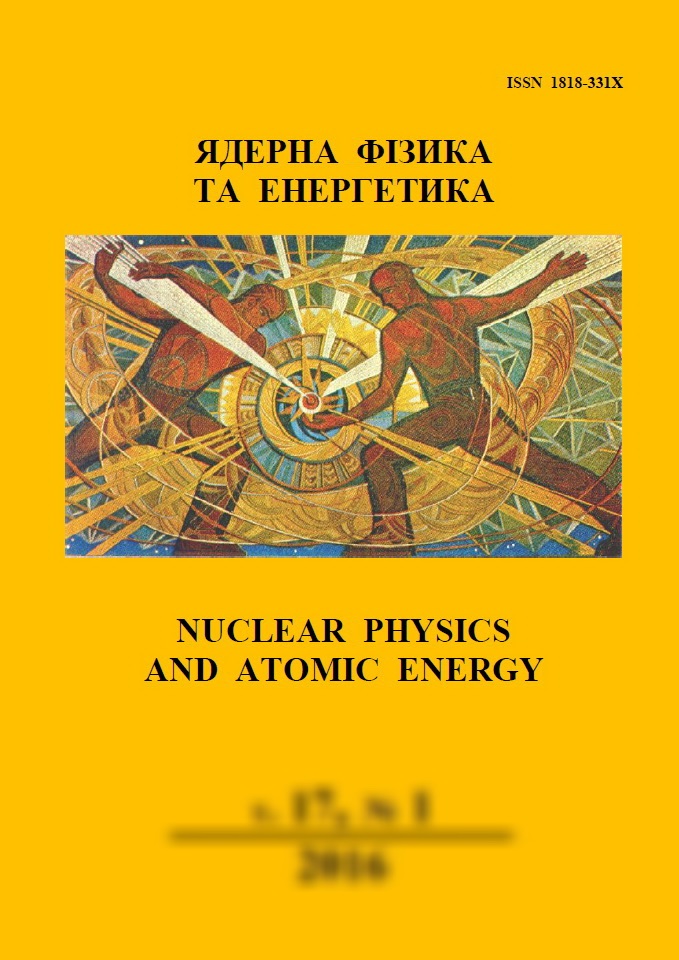 |
ßäåðíà ô³çèêà òà åíåðãåòèêà
Nuclear Physics and Atomic Energy
ISSN:
1818-331X (Print), 2074-0565 (Online)
Publisher:
Institute for Nuclear Research of the National Academy of Sciences of Ukraine
Languages:
Ukrainian, English
Periodicity:
4 times per year
Open access peer reviewed journal
|
Nucl. Phys. At. Energy 2023, volume 24, issue 4, pages 382-387.
Section: Engineering and Methods of Experiment.
Received: 18.05.2023; Accepted: 22.11.2023; Published online: 28.12.2023.
 Full text (en)
Full text (en)
https://doi.org/10.15407/jnpae2023.04.382
The computer model of a neutron fluxes forming system on a linear electron accelerator
S. P. Gokov1,*, V. M. Horbach2, Yu. G. Kazarinov1, V. V. Kantemirov1, V. I. Kasilov1, L. N. Kolpakova2, O. A. Lyukhtan2, E. V. Tsiats’ko1
1 National Science Center “Khark³v Institute of Physics and Technology”, Khark³v, Ukraine
2 V. N. Karazin Kharkiv National University, Kharkiv, Ukraine
*Corresponding author. E-mail address:
gokovsp@kipt.kharkov.ua
Abstract:
A computer model of the system for generating neutron fluxes at the output of a linear electron accelerator has been developed in the Geant4 and PhysList QGSP BIC HP programming environment. With the help of the model, a number of virtual experiments on 107 primary neutrons were carried out. The dependence of the ratio of the number of neutrons, incident on the detector with a reflector to the number of neutrons without a reflector on the radius of curvature of the hemispherical dome of the reflector is determined, which makes it possible to establish the optimal dimensions of the working area. The energy spectra of neutrons incident on the detector are determined. It has been established that when using a graphite reflector 30 × 30 × 30 cm in size with a radius of curvature of the hemispherical dome of 5 cm, the number of neutrons at the location of the detector increases by 16.9 %, and the neutron background in the accelerator bunker decreases by 2.5 times, which is in good agreement with the real experiment made. Such a decrease in the radiation background, according to sanitary standards, will make it possible to increase the accelerator current by 2.5 times and increase the neutron flux.
Keywords:
computer model, accelerator, reflector, neutrons detector, energy spectra.
References:
1. V. Kasilov et al. Concept of Neutron Source Creation for Nuclear Medicine on the Basis of Linear Electron Accelerator. East European Journal of Physics 4 (2021) 160.
https://doi.org/10.26565/2312-4334-2021-4-21
2. V.V. Mitrochenko et al. Neutron source at the output of the LUE-40 linear electron accelerator. In: Abstracts of the XX Conference on High Energy Physics and Nuclear Physics, Kharkiv, 2022 (Kharkiv: NSC KIPT, 2022) p. 25. (Ukr)
https://www.kipt.kharkov.ua/conferences/ihepnp/2022/tezis.pdf
3. I.M. Karnaukhov. On construction of the subcritical nuclear facility "Neutron source" (by materials of scientific report at the meeting of Presidium of NAS of Ukraine 2 July 2014). Visnyk of the National Academy of Sciences of Ukraine 9 (2014) 23. (Ukr)
http://dspace.nbuv.gov.ua/handle/123456789/69966
4. Physics Reference Manual. Release 10.4. Geant4 Collaboration (CERN, 2017) 354 p.
https://indico.cern.ch/event/679723/contributions/2792554/attachments/1559217/2454299/PhysicsReferenceManual.pdf
5. A.N. Klimov. Nuclear Physics and Nuclear Reactors (Moskva: Atomizdat, 1985) 384 p. (Rus)
6. V.Å. Levin. Nuclear Physics and Nuclear Reactors. 4th ed. (Moskva: Atomizdat, 1979) 288 p. (Rus)
7. S.P. Gokov et al. Development and Testing of a System for Forming Neutron Fluxes on a Linear Electron Accelerator. Probl. At. Sci. Tech. Ser.: Nuclear Physics and Elementary Particles 5(141) (2022) 73.
https://doi.org/10.46813/2022-141-073
